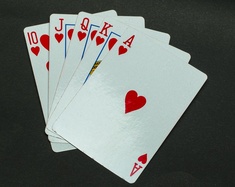
Card Game 101 #10: Rummy 500
First published: Tuesday February 15th, 2022
Report this blog
Introduction
Rummy 500 is a variation of the card game Rummy. It is just as fun to play - be the first to reach 500 points to win! Read on to learn the basics of the card game Rummy 500.
Needed
✔ 2-8 players
✔ For 2-4 players: a standard 52-card deck
✔ For 5-8 players: two 52-card decks
Setup
First of all, choose the dealer. The dealer can be selected by the players themselves, or using the following method:
- Each player draws one card from the deck. The player who draws the highest number gets to deal (for this purpose, count aces as 1, jacks as 11, queens as 12, and kings as 13). If two or more players tie for the highest number drawn, have the tying players re-draw from the deck.
Next, depending on the number of players in the game, the dealer deals out a number of cards to each player:
✔ For 2 players: 13 cards/player
✔ For 3-8 players: 7 cards/player
All these deals are carried out clockwise and starting with the player to the dealer's left.
Finally, place the remaining deck into the middle of the playing area as a draw pile. Flip up the top card and place it next to the draw pile to begin the discard pile.
Object of the Game
Gameplay
After a card is drawn, the player will lay down any melds they have in their hand. There are two different types of melds. A set is three or four cards of the same rank, and a run is three or more consecutive cards of the same suit. For example:
✔ Set: 3 of hearts + 3 of spades + 3 of diamonds (+ 3 of clubs)
✔ Run: (... + 4 of spades +) 5 of spades + 6 of spades + 7 of spades (+ 8 of spades + ...)
If there is a meld already laid down on the table, the player can add any valid cards from their hand to that meld. For example, if a run of 4♣+5♣+6♣ is laid on the table, the player can add to the meld by laying down a 3♣ or a 7♣. Players will keep their added cards in front of them for scoring purposes.
After a player has laid down all their melds and added to existing melds, they will end their turn by discarding a card. The discard is placed on top of the discard pile. Play then moves to the next player. Play continues this way until one player has no cards left in hand, or until the draw pile runs out and the next player does not wish to draw from the discard pile.
Scoring and Winning
At the end of a round, players will score points based on the cards melded and, if any, the cards remaining in hand. Players will have points deducted for cards left in their hands.
✔ Ace = 15 points in a set and 1 point in a run
✔ 2-10 = face value
✔ Face card = 10 points
An ace left in hand is a 15-point loss.
The first player to 500 points wins the game.
Rules
✔ The ace is always low when melded in a run.
✔ If a player chooses to draw from the discard pile, the card drawn must be melded within the same turn.
✔ Once a meld is laid down, it cannot be moved or separated.
✔ If a player has a meld still in their hand when another player runs out of cards, the card points will be deducted when scoring.
✔ If a player notices a card in the discard pile that can be melded after another player has ended their turn, that player can announce rummy, draw from the discard pile to the card that can be melded, and make the meld. The player that announced rummy will discard to end their turn, and play moves right to the next player.
✔ If two decks are used, set melds cannot contain two cards of the same suit.
Up Next
The next blog in this series will be about the card game Page One. Expect it to come within a week.
Thanks for reading!
